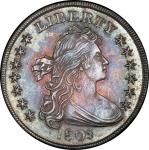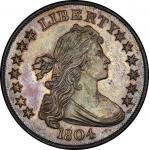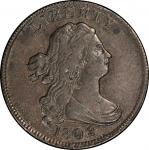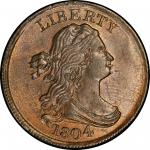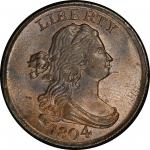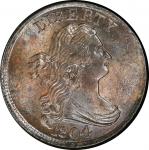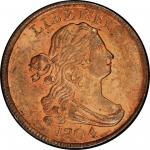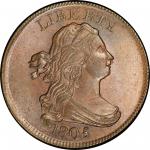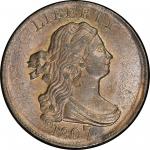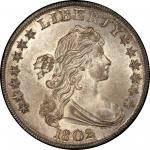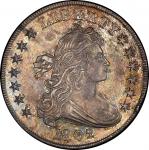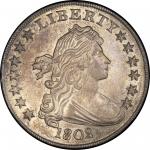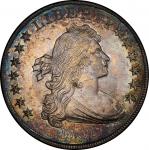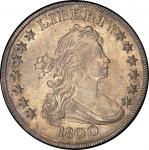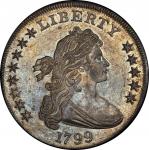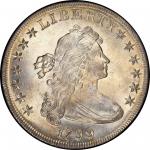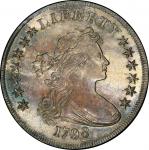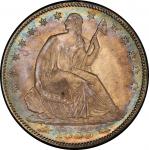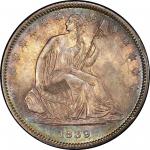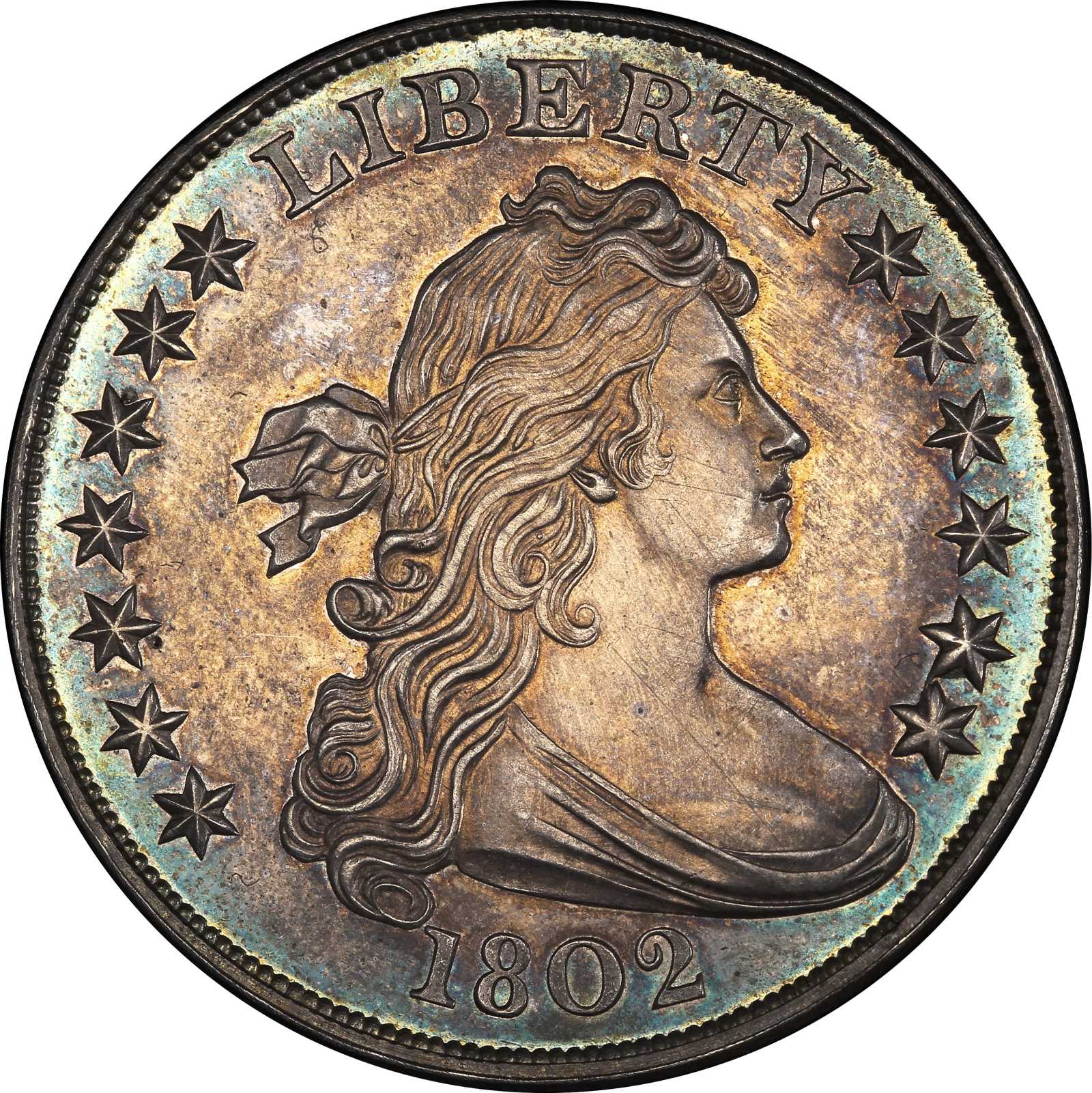It is now also positively known that the dollars of 1801, 1802, and 1803 were restruck by the same parties who restruck the 1804 dollar. - Ed. Frossard, Numisma, December 1885Dated earlier but struck later, this rare production is kin to the Original 1804 dollar offered in the pages that follow. In fact, in 1941, this precise coin was offered two lots before the Dexter-Dunham 1804 dollar, and today the planets align once again.The visual appeal and technical quality appear to surpass the assigned grade, with beautiful green and blue toning framing golden gray centers and fields rich with reflectivity. The strike is just as firm at center as the 1804 Original, but surpasses its detail at the peripheries. All stars except star 13 show complete centers, and the top curls of Libertys hair are nicely defined. The reverse is definitively detailed throughout. Indeed, the reverse was struck too firmly, as the strength of the strike created what the minters called a "fin," though it is more commonly known today as a "wire rim." Considered an error by the coiners, it was filed down at the U.S. Mint with extraordinary care to not touch any other portions of the coin. Today, that edge filing is most readily seen above UNITED, STATES, and RICA. Vestiges of fin reduction are also visible in some spots around the obverse.The surfaces are marvelously preserved, with nothing more than the most trivial hairlines, save for a single hairline of slightly greater severity that descends diagonally down Libertys chest. Tiny depressions, created by extraneous material on the die face at the moment of striking, are seen right of star 3, above star 5, below IT of UNITED, left of the top of A in STATES, left of star 8 in the reverse cluster, and below the left upright of M in AMERICA. Lintmarks, remnants of the die polishing process that attempted to remove that extraneous material from the die faces, are present within Libertys hair near central obverse, below star 1, below L of LIBERTY, and curled up between IC of AMERICA.This obverse die uses the same master portrait hub as the 1804 dollars, but before an injury to that punch truncated the upturned curl below B of LIBERTY. This aspect is present on the Proof Restrikes dated 1802 and 1803 but missing on the related issues dated 1801 and 1804, proving that the die for this coin was actually made before the obverse die of even the Original 1804 dollars. The portrait shows rust trapped between the hair bow and the back of Libertys head, a less extensive show of decay than seen on the 1804 dollars. The die is essentially perfect, but for a short heavy crack that connects stars 12 and 13. The reverse die is in a later state than seen on the 1804 originals, with the crack that connects the tops of NITED extending all the way to the wingtip at left.A coin of elegance, mystery, and rarity that exceeds that of its better known 1804-dated brethren, the 1802 Proof Restrike is a product of the U.S. Mints most fruitful era of shenanigans. With Dr. Henry R. Linderman at the helm as Mint director, a group of obsolete dies that had been locked away in a sealed box were rediscovered and put into use beginning in 1867. Lindermans hijinks were temporarily ended when his term as Mint director ended in 1869, leading to mild and ineffective recriminations against production of restrikes, patterns and off-metal pieces during the term of James Pollock. In 1872, Pollock issued a circular letter that ordered: "No coins or pattern pieces shall be struck after the year of their date; and to insure this, the dies shall be rendered unfit for that use. It is not desirable to make them as common as the Proofs of regular coinage." When Pollock left office in 1873, Linderman returned; it is no coincidence that the Proof Restrike dollars of 1801, 1802, and 1803 are struck on planchets intended for 420 grain trade dollars, first coined that year.The very existence of 1802-dated Proof dollar dies is mysterious. Though this coin and its kin were likely struck between 1873 and 1876, the obverse die that produced this coin was made before 1834, perhaps as early as 1831. R.W. Julian has theorized that dollar coinage was planned in April 1831, after a substantial deposit to the Mint merited sending a request to President Andrew Jackson to lift the ban on dollar production that had been in place since 1806. Jackson dispensed with the rule on April 18, 1831, and it is possible the backdated dies were produced soon thereafter in expectation of an abrupt resumption of the dollar denomination. While the evidence for this theory is admittedly thin, no other explanation has ever been presented as to why a Proof die dated 1802 would be produced sometime between 1828 and 1834 then left unused until about 1873.The mystery that surrounds this issue makes this coin even more interesting than its exceptional preservation or extensive provenance would on their own. Most or all of the Proof Restrikes of 1801, 1802, and 1803 are thought to have been marketed by John Haseltine in the 1870s. This piece entered the published record in 1921, when it sold as part of the collection of Dr. G.F.E. Wilharm of Pittsburgh, who had made a fortune selling salves. While Wilharm died in 1920, his sons carried on the family business until a Federal inquiry found that their salves "consisted essentially of lead compounds such as lead oleate and lead oxide, camphor, an extract of woody material, such as elm bark, and fat." It is little wonder that the coroner of the city of Pittsburgh died in May 1886 after declining the services of his family doctor in favor of Wilharms salves. Despite this making front page headlines, Wilharms business - and coin collection - continued to grow.In 1885, when the Proof 1802 Restrike dollars and related issues had trickled into the numismatic marketplace, Ed. Frossard commented knowingly in his house organ Numisma that the pieces had been struck recently but were "called Proofs from abroad and found a ready sale among collectors." Not unlike Dr. Wilharms salve, they were not what they purported to be, yet found a ready marketplace. Unlike Wilharms phony medicine, their rarity has earned them a place in numismatic lore, giving them highlight status in advanced collections of early dollars.

